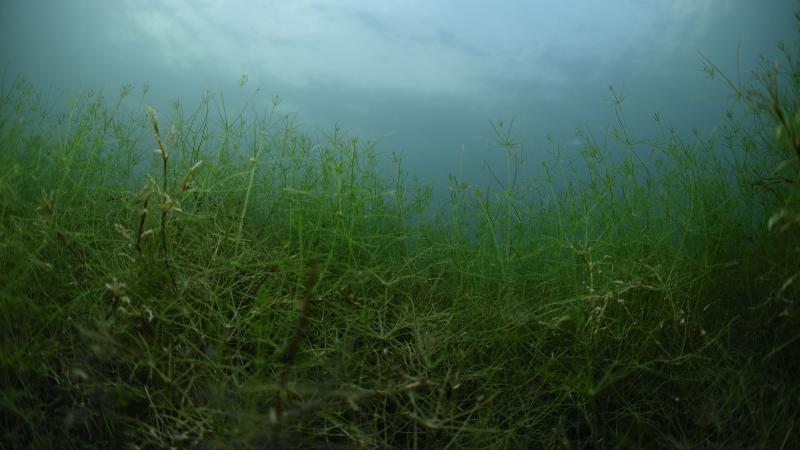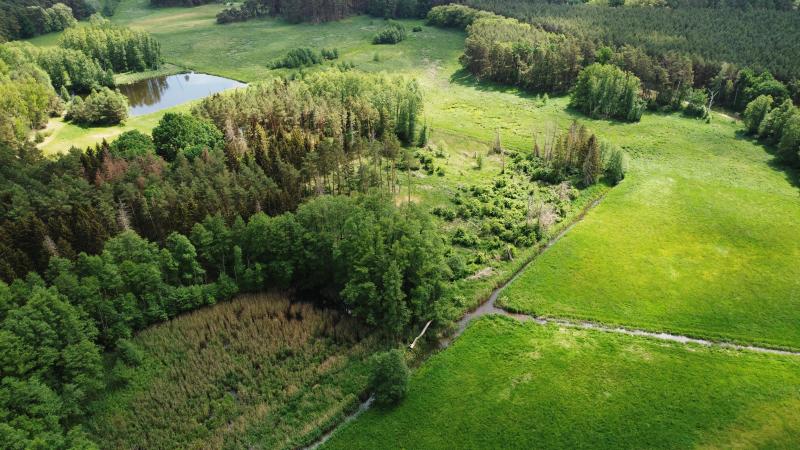
Dörthe Tetzlaff inspecting the soil profile during installation of soil moisture probes in the Demnitz Mühlenfließ test field. © Hauke Dämpfling/IGB
Professor Tetzlaff, the word drought conjures up images of weeks without rain, dried-up soils and parched vegetation. As a hydrologist, what is your perspective on this?
Dörthe Tetzlaff: In principle, that's all true. But droughts also have other symptoms, such as the intermittent drying up of surface water. This, along with changes in soil moisture, is relatively well understood. What many people do not immediately think about is that even during drought periods there is still water deep below the earth's surface and below the root zone. Think of the landscape as a bathtub: During humid periods it is well filled – this is known as saturation. The hydrological connectivity is high and 'excess' water flows out continuously. In dry periods, the water continuum decreases and is more and more disconnected. In some places there is still water, in others there is none – partly because water is depleted differently in each part of the landscape, with evaporation playing a major role. This is also why drought does not have the same effect everywhere and at all times.
And that is why it is so important to consider the effects of drought at the landscape scale?
DT: Yes, especially the intermediate landscape scale (10-100 km²) is often the most tangible and relevant for catchment managers. It is at this scale that process-based knowledge can be gained that is meaningful for the whole area. Currently, most drought projections are based on limited data, a simplified representation of landscape characteristics and a focus on very small (less than 10 km²) or very large (more than 1000 km²) spatial scales. The intermediate landscape scale is important because it reflects the diversity of our landscapes in terms of different land use mosaics, including agriculture, forests and wetlands. And there's another reason: in most climate zones - with the exception of arid and semi-arid areas – streams usually remain perennial, but with increasing drought even here, larger sections can dry up more frequently and be disconnected from the rest of the landscape for longer periods of time – with dramatic consequences for biodiversity or ecosystem services.
Can you explain why landscape mosaics play a central role in the assessment of droughts?
DT: Landscapes are highly heterogeneous in terms of topography, soil types and geology. These characteristics determine where the key zones of water storage are located in the landscape. The impact of a drought is largely determined by the land cover, as different types of vegetation have different evaporation and transpiration rates, which in turn depend on the availability of water in the subsurface. Droughts therefore do not affect entire regions or landscapes in the same way, but rather the effects of drought are unique and vary from one part of the landscape to another. For example, in many temperate and boreal catchments, wetlands, especially peatlands with deep organic soils, which are more resistant to water drawdown during droughts and are often located in valley bottoms and topographic hollows, are the 'hot spots' of large subsurface water storage. In contrast, in more elevated areas with thin soils dry depletion and drawdown of water is more rapid, resulting in less ecohydrological resilience and higher vulnerability to drought.

© David Ausserhofer/IGB
"In the face of increasing drought risks, we need to ensure that our landscapes are resilient enough to cope with these challenges. This is not only a question of ecology, but also of our livelihoods."
Professor Dörthe Tetzlaff
How do you approach the scientific analysis of this problem of heterogeneity of drought impacts and vulnerability?
DT: Access to the so-called storage continuum, i.e. the amount of water stored in the subsurface, i.e. in the soil and underlying aquifers, is crucial. The volume and connectivity of this storage continuum determines whether water-related ecosystem services can be provided at the landscape level at all times, from the wettest to the driest periods. In general, the greater the diversity of the landscape, the more connections to the storage continuum are potentially available. And that enhances ecohydrological resilience. The storage continuum ranges from areas with high storage and ecohydrological resilience, such as wetlands, to areas with low storage and low ecohydrological resilience, such as agricultural land and forest monocultures.
How do these different reservoirs respond to drought, and what are the consequences for vegetation?
DT: Under normal, humid conditions, the underground reservoirs are interconnected and extend both vertically and horizontally. The above-ground reservoirs – surface water and soils – are sufficiently replenished by regular rainfall. In times of drought, the above-ground reservoirs are depleted. Arable land is more sensitive than trees stands due to shallower root systems. As the drought progresses, the roots are cut off from deeper, older water sources. Water levels in lakes and rivers also drop. During this phase, trees with their extensive root networks can often tap into even deeper water reservoirs. Less productive grasslands and wetlands are less affected by drought than arable land because they evaporate less water and are better connected to groundwater reservoirs. If water is not replenished, the above-ground reservoirs of all land use types will be depleted as drought increases, with wetlands remaining the most resilient. Under such extreme conditions – where there is no recharge and groundwater levels fall – deeper reservoirs may also become depleted. The potential consequences range from less reversible tipping points to crop failure, desiccation of grasslands, decline of forest growth or death of forests, desiccation of wetlands, disconnection of canal networks and river flows.
How can we make use of this knowledge to better prepare for drought periods in the future?
DT: A better understanding of where water is stored and where it is lost in catchments, and how low precipitation and high evaporation rates affect water flows and the storage continuum in landscapes, provides the basis for new, resilience-enhancing approaches in land and water management. Maintaining and creating landscape mosaics is crucial to increasing the resilience of our landscapes. This includes different patterns of land use, evapotranspiration, groundwater recharge and storage dynamics. For example, in one of our long-term study areas in Brandenburg, Germany – one of the Ecohydrology Demonstration Sites of UNESCO's Intergovernmental Hydrological Programme – we have found that uneven-aged mixed forests are the most resilient to drought because they reduce evapotranspiration and increase groundwater recharge and flow compared to other types of vegetation.
Read the article in Nature Water >






